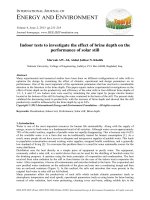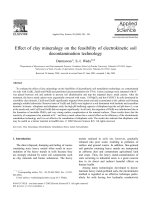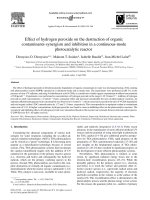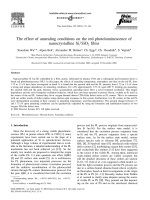EFFECT OF INHIBITION OF S-NITROSOGLUTATHIONE REDUCTASE ON THE NF-κB PATHWAY
Bạn đang xem bản rút gọn của tài liệu. Xem và tải ngay bản đầy đủ của tài liệu tại đây (1.44 MB, 71 trang )
EFFECT OF INHIBITION OF S-NITROSOGLUTATHIONE
REDUCTASE ON THE NF-κB PATHWAY
Sharry L. Fears
Submitted to the faculty of the University Graduate School
in partial fulfillment of the requirements
for the degree
Master of Science
in the Department of Biochemistry and Molecular Biology
Indiana University
September 2009
ii
Accepted by the Faculty of Indiana University, in partial
fulfillment of the requirements for the degree of Master of Science.
________________________________
Sonal P. Sanghani, Ph.D., Chair
________________________________
Paresh C. Sanghani, Ph.D.
Master’s Thesis
Committee
________________________________
William F. Bosron, Ph.D.
iii
To my Son, Nick
Thank you for your encouragement, patience,
and support.
iv
ACKNOWLEDGEMENTS
I would like to thank the following people who have been a part of my life
and helped me through the task of completing this master of science.
• Dr. Sonal Sanghani, for being a friend, colleague and mentor.
Thank you for believing in me and encouraging me when I would
start doubting myself. Thank you for sharing your Indian culture
and customs.
• Dr. Paresh Sanghani, for being a great mentor, colleague and friend.
Thank you for sharing your expertise in expressing proteins,
excitement for your work, and your patience.
• Dr. William Bosron, for being a mentor, friend and colleague.
Thank you for your guidance and sharing your incredible knowledge
of science.
• Lanmin Zhai, my lunch time friend and colleague. Thank you for
sharing your culture and Chinese food at lunch.Thank you for all the
laughter and support.
• Wil Davis, lab mate and friend. Thank you for all your expertise
and guidance. Thank you for sharing your Dutch culture.
v
• Scheri Green, lunch time friend, thank you for being a wonderful
friend and colleague. Thank you for sharing your culture with me
and encouraging me to visit the Caribbean.
• Dr. Marissa Schiel, thank you for all the encouragements and for
being my ‘psychiatrist’. Thank you for being a great friend and
colleague.
• Darlene Lambert, for being a great friend and colleague. Thank you
for all the rushed orders and late orders. Thank you for all the great
times.
• Jack Arthur, for being a great friend and colleague. Thank you for
always coming to my rescue with my computer issues.
• Dr. Ross Cocklin, for being a friend and colleague. Thank you for
answering my many questions on yeast and mass spectrophotometry.
• Josh Heyen, for being a friend and colleague. Thank you for the
interesting lunch time conversations. Thank you for being my farm
cohort.
vi
TABLE OF CONTENTS
List of Tables viii
List of Figures ix
List of Abbreviations x
INTRODUCTION
I. Characterization of S-nitrosoglutathione Reductase 1
II. Effects of the Inhibition of GSNOR 6
III. Effects on NF-κB Pathway 7
IV. Small Molecule Inhibitors of GSNOR 10
V. Biotechnology 15
MATERIALS AND METHODS
I. Cytotoxicity of GSNOR Inhibitors 16
II. Identification of S-nitrosylated Proteins 17
III. Effect of Inhibitor C3 on NF-κB Pathway Proteins 23
IV. Proteins Affected by Inhibition of NF-κB Pathway 24
RESULTS
I. Cytotoxicity of GSNOR Inhibitors 26
II. Identification of S-nitrosylated Proteins 31
vii
III. Effect of Inhibitor C3 on IKKβ Activity 36
IV. Proteins Affected by Inhibited NF-κB Pathway 42
DISCUSSION
I. Inhibitors of GSNOR 44
II. Biotechnology 49
CONCLUSION 52
REFERENCES 53
CURRICULUM VITAE
viii
LIST OF TABLES
1. In vitro Percent Inhibition and IC
50
of C1, C2, and C3 11
2. Compound Inhibition Comparison of ADHs 12
3. Treatments of RAW 264.7 cells with C3 19
ix
LIST OF FIGURES
1. GSNOR Catalytic Reaction 1
2. Substrates for GSNOR 3
3. Structure of GSNOR Homodimer 4
4. GSNOR Reduction of GSNO 6
5. NF-κB Pathway 9
6. Inhibitors of GSNOR 14
7. Inhibition of A549 cells by C2 using BrdU Incorporation 27
8. Inhibition of A549 cells by C3 using BrdU Incorporation 28
9. Inhibition of A549 cells by C3 with and without TNFα 29
10. Cell Viability after 10 hours of Incubation with Inhibitors. 30
11. Schematics of the Biotin Switch Assay 32
12. Nitrosylated Proteins after Treatment with C2 or C3 34
13. S-nitrosylated IKKβ of Treated Samples Following Inhibition with C3 . 36
14. Effect of C3 on the Phosphorylation of IκB 38
15. Effect of C3 on the Phosphorylation of IκB in the Presence of a
Proteasome Inhibitor 40
16. IKKβ Phosphorylation in A549 cells 41
17. Expression of ICAM-1 is Regulated by NF-κB 43
18. NO Bioactivity and Signaling Pathway 45
19. NF-κB Pathway 4
x
LIST OF ABBREVIATIONS
12-HDDA
12-hydroxydodecanoic acid
12-ODDA
12-oxododecanoic
A549
human lung carcinoma epithelial cell line
ADH
Alcohol dehydrogenase
ADH1B
Alcohol dehydrogenase 1B; β
2
β
2
-ADH
ADH4
Alcohol dehydrogenase 4; π-ADH
ADH7
Alcohol dehydrogenase 7; σσ-ADH
ALF
airway lining fluid
Biotin-HPDP
N-[6-(Biotinamido)hexyl]-3´-(2´-pyridyldithio)propionamide
BOG
β-octyl glucoside
BrdU
bromodeoxyuridine
BSA
bovine serum albumin
C1
3-[1-(4-acetylphenyl)-5-phenyl-1H-pyrrol-2-yl]propanoic
acid
C2 5-chloro-3-{2-[(4-ethoxyphenol)(ethyl)amino]-2-oxoethyl}-
1H-indole-2-carboxylic acid
C3 4-{[2-[(2-cyanobenzyl)thio]-4-oxothieno[3,2-d]pyrimidin-
3(4H)-yl]methyl} benzoic acid
DMSO dimethyl sulfoxide
EDTA
Ethylenediaminetetraacetic acid
FDH
Formaldehyde dehydrogenase
xi
GAPDH
Glyceraldehyde-3-phosphate dehydrogenase
GSH
glutathione
GSNO
S-nitrosoglutathione
GSNOR
S-nitrosoglutathione redutase
GSSG
glutathione disulfide
HEN
Hepes, EDTA, neocupronine
HMGSH
hydroxymethylglutathione
HRP
horseradish peroxidase
IC
50
half maximal inhibitory concentration
ICAM
intercellular adhesion molecule
IκB
inhibitor kappa B
IKKβ
inhibitor kappa B kinase beta
iNOS
Inductible nitric oxide synthase
L-NAME
Nώ-Nitro-L-arginine methyl ester hydrochloride
MG-132
Carbobenzoxy-L-leucyl-L-leucyl-L-leucinal
mICAM
transmembrane intercellular adhesion molecule
MMTS
S-methylmethanethiosulfonate
MTS
3-(4,5-dimethylthiazol-2-yl)-5-(3-carboxymethoxyphenyl)-2-
(4-sulfophenyl)-2H-tetrazolium
NAD
+
Nicotinamide adenine dinucleotide
NADH
Nicotinamide adenine dinucleotide reduced
NF-κB
Nuclear factor-kappa B
xii
NO
nitric oxide
PBS
phosphate buffered saline
pIκB
phosphorylated inhibitor kappa B
pIKKβ
phosphorylated inhibitor kappa B kinase beta
PVDF
Polyvinylidene difluoride
RAW 264.7
mouse Abelson murine leukemia virus transformed
macrophage cells
RBC red blood cells
SDS
sodium dodecyl sulfate
sICAM
soluble intercellular adhesion molecule
SNO
S-nitrosothiol
TBS
Tris buffered saline
TBS-T
Tris buffered saline with tween
TNFα
tumor necrosis factor alpha
WT
wild type
βME
beta mercaptoethanol
1
INTRODUCTION
I. Characterization of S-nitrosoglutathione Reductase
S-nitrosoglutathione reductase (GSNOR) also known as glutathione-
dependent formaldehyde dehydrogenase (FDH), is a zinc-dependent
dehydrogenase. It is a member of the alcohol dehydrogenase (ADH) family and is
also called Class III alcohol dehydrogenase. The substrate specificity of GSNOR
has been well studied (Holmquist and Vallee, 1991; Wagner et al., 1984). It
oxidizes long chain alcohols to an aldehyde with the help of a molecule of NAD
+
(Figure 1). Alcohols with a carbon chain longer than four carbons and containing
a carboxyl group at the opposite end are metabolized by GSNOR much more
efficiently than ethanol (Sanghani et al., 2000; Wagner et al., 1984) an example is
12-hydroxydodecanoic acid (Figure 2A). As the carbon chain length of alcohol
increases, the K
m
of the alcohol decreases (Wagner et al., 1984).
Figure 1. GSNOR Catalytic Reaction. GSNOR oxidizes an alcohol
to aldehyde using NAD
+
as a coenzyme.
2
GSNOR was initially identified as FDH because of its role in the
formaldehyde detoxification pathway. Hydroxymethylglutathione (HMGSH) is
formed by the spontaneous reaction of formaldehyde and glutathione (GSH).
FDH oxidizes HMGSH to S-formylglutathione (Figure 2B) with the help of
NAD
+
. S-formylglutathione is further converted to formic acid and glutathione
enzymatically by S-formylglutathione hydrolase. Removal of formaldehyde from
the cells protects the cells from its detrimental effects. Formaldehyde is
detrimental to cells because it can modify proteins, damage membranes, and cause
mutagenesis through DNA-protein cross-links (Barber and Donohue, 1998).
Formaldehyde was commonly used as a fixative for cell and tissue cultures until it
was declared a carcinogen.
3
A)
B)
Figure 2. Substrates for GSNOR. A) In vitro reaction of GSNOR:
12-HDDA is an example of a long chain primary alcohol with a
carboxyl group which GSNOR oxidizes to an aldehyde. B) GSNOR
plays a key role in the removal of formaldehyde from the body.
Formaldehyde spontaneously reacts with GSH to form HMGSH,
GSNOR catalyzes the reaction of HMGSH to S-formylglutathione
which is hydrolyzed to glutathione and formic acid by S-
formylglutathione hydrolase.
The crystal structure of GSNOR has been determined (Yang et al., 1997)
and the enzyme exists as a homodimer in its native state. GSNOR contains a
coenzyme binding site for NAD
+
/NADH and a substrate binding site for GSNO or
long chain alcohols (Figure 3).
4
Figure 3. Structure of GSNOR Homodimer. Each GSNOR
monomer contains a zinc ion, coenzyme binding site for NADH, and
catalysis binding site for substrate.
GSNOR is ubiquitously expressed in tissues as compared to other ADHs
(Kaiser et al., 1989; Sanghani et al., 2000; Estonius et al., 1996). One
characteristic of ubiquitously expressed genes is the absence of a TATA box or a
CAAT box in its promoter region (Hur and Edenberg, 1992), as is the case in
GSNOR. GSNOR is a highly conserved enzyme and can be found in both
prokaryotic and eukaryotic organisms. GSNOR has been maintained throughout
evolution and is vital for NO homeostasis as a regulator for protein S-nitrosation
through the reduction of GSNO (Liu et al., 2001). Although GSNOR is expressed
5
in all tissue, its activity levels are highest in the liver followed by kidney, heart,
lung, spleen and thymus (Liu et al., 2004).
GSNOR was very well characterized as FDH until a report by Liu et al.
identified NADH dependent GSNO-metabolizing enzyme as FDH by mass
spectrophotometry (Liu et al., 2001). Subsequent studies revealed the GSNOR’s
oxidation rate for HMGSH is two to eight fold higher when GSNO is available
than for HMGSH alone (Staab et al., 2008). The only S-nitrosothiol (SNO)
substrate recognized by GSNOR is GSNO (Liu et al., 2004). A transnitrosation
reaction transfers NO from nitrosylated proteins or S-nitrosothiols (RSNO) to
glutathione to form S-nitrosoglutathione. This GSNO is finally converted to
glutathione disulfide (GSSG) by a two step mechanism. First, GSNOR reduces
GSNO to N-hydroxysulfenamide-glutathione (Fukuto et al., 2005) in the presence
of NADH followed by non-enzymatic reaction of N-hydroxysulfenamide-
glutathione and glutathione to glutathione disulfide and hydroxylamine (Figure 4).
Cellular GSNO is a nitric oxide reservoir that can either transfer to or remove from
the proteins a NO group. Reduction of GSNO by GSNOR depletes this reservoir
and therefore indirectly regulates protein nitrosylation.
6
Figure 4. GSNOR Reduction of GSNO. The figure above shows
the reduction of GSNO by GSNOR to a final product of GSSG and
hydroxylamine.
II. Effects of the Inhibition of GSNOR
The role of GSNOR in NO metabolism is very well established by studies
in GSNOR knockout mice (Liu et al., 2004). The effect of inhibition in GSNOR
should result in an increase in RSNOs which is what was observed in GSNOR
knockout mice (Liu et al., 2004). After treatment with lipopolysaccharide,
RSNOs in GSNOR
-/-
mice increased 3.3-fold and 29-fold over wild-type (WT)
mice at 24 and 48 hours, respectively. Of the RSNOs in the GSNOR
-/-
mice 90%
are RSNOs with molecular weights >5000 (Liu et al., 2004). This increase in
RSNOs effects vascular homeostasis, asthma, and cystic fibrosis. Hypotension
was amplified in anesthetized GSNOR
-/-
mice over WT mice. The basal levels of
SNOs in RBC’s from GSNOR
-/-
mice were 2-fold higher, this amount would cause
vasodilation in bioassays (Liu et al., 2004). In the study by Que et al., WT mice
exposed to the allergen ovalbumin exhibited airway hyperresponsivity and were
depleted of lung SNOs likely due to increased GSNOR activity seen in these mice.
7
In the same study, GSNOR
-/-
mice do not show airway hyperresponsivity upon
exposure to ovalbumin (Que et al., 2005). Using a Human Airway Bioassay
technique, Gaston et al. documented GSNO concentrations in asthma patients to
be much lower than in control patients and correlated inversely to NO
concentrations (Gaston et al., 1993). Elevated NO in patient’s exhaled air, is one
of the top symptoms in the diagnosis of asthma (Que et al., 2005). A depletion of
GSNO in the airway lining fluid (ALF) of asthmatic patients also correlates with
this symptom. In a clinical study, asthma patients have shown to have two times
higher GSNOR activity than controls and depleted GSNO and SNOs in
bronchoalveolar samples (Que et al., 2009). Asthma and cystic fibrosis patients
have a decrease in GSNO concentration in the airway lining fluid. One treatment
being investigated for cystic fibrosis patients is inhaling aerosolized GSNO (Foster
et al., 2003; Zaman et al., 2006). GSNOR inhibitors which can increase the basal
GSNO levels will be another potential therapy.
III. Effects on NF-κB Pathway
The NF-κB Pathway is regulated by series of positive and negative
regulatory elements. Positive regulation causes phosphorylation of IKKβ, which
in turn phosphorylates IκB. IκBα is an inhibitory molecule that sequesters NF-κB
in the cytosol. Phosphorylation of IκBα targets it for ubiquination and
proteasomal degradation releasing NF-κB (Figure 5). NF-κB then travels to the
nucleus and initiates transcription of cytokines, chemokines, which includes genes
8
such as NOS, tumor necrosis factor alpha, (TNFα), intercellular adhesion molecule
(ICAM), and self regulation. ICAM is a transmembrane protein (mICAM) or a
soluble protein (sICAM) which is produced in epithelial cells and leukocytes
(Hayden et al., 2006; Whiteman and Spiteri, 2008). ICAM adheres the leukocytes
to the affected endothelial cells. Leukocytes are the defense mechanism of the
body and will migrate into the infected tissue (Hayden et al., 2006). Mice that
have inadequate amounts of p65 NF-κB lack the ability to adhere leukocytes to the
epithelial cells which slows the immune response (Hayden et al., 2006).
The role of nitric oxide in regulation of NF-κB pathway is reviewed by
Bove and van der Vliet (Bove and van der Vliet, 2006). IKKβ has been shown to
be a direct target for SNO modification resulting in decreased IKKβ activity
causing inhibition of NF-κB dependent transcription (Reynaert et al., 2004).
Asthma is the overstimulated inflammatory pathway in response to allergens
entering the respiratory system. The fact that asthma patients have decreased
amounts of GSNO could result from overproduction of GSNOR causing an
imbalance of NO and S-nitrosylated proteins; therefore activating the NF-κB
pathway and consequently the immune response. Inhibiting GSNOR would
prevent the rapid removal of NO from S-nitrosylated proteins including IKKβ and
therefore could impede the NF-κB pathway, slowing the immune response in
asthma patients (Figure 5).
9
Figure 5. NF-κB Pathway. The NF-κB is a key transcription factor
for the transcription of cytokines and chemokines.
10
IV. Small Molecule Inhibitors of GSNOR
High-throughput screening was performed using ChemDiv Inc’s small
molecule library of 60,000 compounds for inhibition of GSNOR activity in
Chemical Genomics Core facility at Indiana University. Recombinant GSNOR
was expressed in E. coli and purified using a previously described method
(Sanghani et al., 2000). In high-throughput screening GSNOR activity was
determined using 384 well plates with substrate octanol and cofactor NAD
+
. The
production rate of NADH absorbance at 340 nm was monitored. Potential
compounds were selected based on the ability to inhibit the activity of GSNOR
and retested in the laboratory using an IC
50
in vitro assay. If the compound
showed a 100 fold lower IC
50
than the known inhibitor dodecanoic acid
concentration in the IC
50
in vitro test (Table 1) they were selected for further
studies. The small molecules were then tested for the inhibition of other ADHs,
allowing selection of compounds that exclusively inhibit GSNOR (Table 2).
11
Compound
Number
%
inhibition
IC
50
at
pH 7.5
µM
pH 10
pH 7.5
Dodecanoic acid 4 19 212
C1 78 93 1.3
C2 55 91 2.4
C3 75 95 1.1
Table 1. In vitro Percent Inhibition and IC
50
of C1, C2, C3. The
percent inhibition was determined using 2 conditions. Inhibition
studies at pH 10 were performed in 0.1 M sodium glycine (pH 10), 1
mM octanol, 1 mM NAD
+
, 0.1 mM EDTA and 50 µM inhibitor.
Inhibition studies at pH 7.5 were performed in 50 mM potassium
phosphate pH 7.5 containing 15 µM NADH, 10 µM GSNO, 0.1 mM
EDTA and 50 µM inhibitor.
12
Enzyme % Inhibition
C1 C2 C3
GSNOR
77
71
73
ADH1B
5
0
5
ADH7
4
13
8
ADH4
6
1
3
Table 2. Compound Inhibition Comparison of ADHs. Inhibition
studies were performed in presence or absence of 5 µM inhibitor at
25ºC in 50 mM potassium phosphate pH 7.5 containing 0.1 mM
EDTA. The enzyme activity was measured by following the changes
in absorbance at 340 nm. The values show the percent reduction in
the enzyme activity caused by the inhibitor. The standard errors are
below 15% of the averages shown, except when the inhibition was
below 20%. Studies with ADH1B (β
2
β
2
-ADH), ADH7(σσ-ADH),
ADH4 (π- ADH) were performed in 0.05 % DMSO. Studies with
GSNOR were performed in presence of 1 % DMSO.
From the in vitro IC
50
and inhibition studies, three candidates, C1, C2, and
C3, (Figure 6A-C) were selected and assessed ex vivo using RAW 264.7
macrophage cells and A549 human carcinoma lung epithelial cells (Sanghani et
al., 2009). Of these three inhibitors all experiments were completed using C3.
Inhibitor C2 experiments were performed during cytotoxicity, nitrosylation, and
C1was only analyzed early in the studies, ie. cytotoxicity experiments. Initially
C3 showed higher level of protein nitrosolyation in cells making C3 our first
choice. Some experiments with C2 were included for comparison to C3.
13
Very little data for C1 was gathered because the results did not show sufficient
nitrosylation in cell lysates compared to C2 and C3. During ongoing experiments
C3 seemed to exhibit more results, ie. detection of more nitrosolyation in cell
lysates, more defined IκB experiments than C2 and C3.









